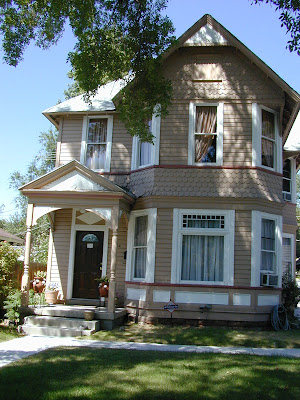 These homes are at 359 and 363 Bryan Avenue, Salt Lake City, Utah. I took this picture in 2007, when I happened upon an open house at 359 Bryan Avenue, the house on the left.
These homes are at 359 and 363 Bryan Avenue, Salt Lake City, Utah. I took this picture in 2007, when I happened upon an open house at 359 Bryan Avenue, the house on the left.According to Nicholas G. Morgan’s biography the home Mellie moved her family to in 1897 was at 363 York Street (York Street was renamed Bryan Avenue prior to the 1910 Census). She was only able to make the move because that year she began receiving a widow's pension from her deceased husband's Civil War Service.
While her son Nick was attending law school and working in Washington D.C. he wrote his Mother a letter on March 15, 1908.
My dear Mother
I must tell you that the senate passed a bill the other day that will raise your pension to $12 p.m [per month]. All that is required is teddy’s [Theodore Roosevelt, U.S. president 1901-1909] signature and it is a law.
Helen M. (Mellie) Morgan family
 1930 Salt Lake City, Utah Census, 359 Bryan Avenue
1930 Salt Lake City, Utah Census, 359 Bryan Avenue
 1930 Salt Lake City, Utah Census, 359 Bryan Avenue
1930 Salt Lake City, Utah Census, 359 Bryan Avenue
Helen M. (Mellie) Morgan family
 This is a picture of Mellie's 359 Bryan Avenue home from my mother, Helen Rex Frazier's, collection. She and so many other family members lived there with their mother and grandmother.
This is a picture of Mellie's 359 Bryan Avenue home from my mother, Helen Rex Frazier's, collection. She and so many other family members lived there with their mother and grandmother.
 This is a picture of Mellie's 359 Bryan Avenue home from my mother, Helen Rex Frazier's, collection. She and so many other family members lived there with their mother and grandmother.
This is a picture of Mellie's 359 Bryan Avenue home from my mother, Helen Rex Frazier's, collection. She and so many other family members lived there with their mother and grandmother.
Mellie didn't own this home, her sister Josephine Groesbeck Smith did. You can see it pictured in a history of one of John Henry and Josephine Groesbeck Smith's descendants here.
(To be continued.)











 Two weeks ago
Two weeks ago